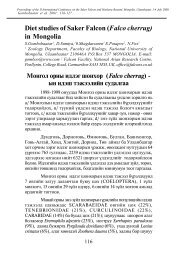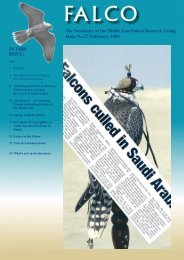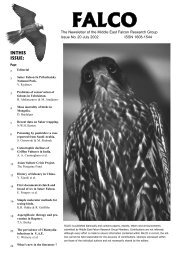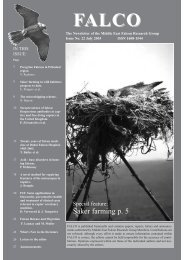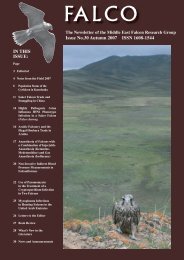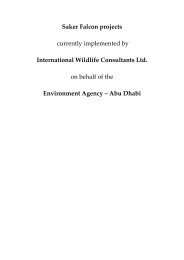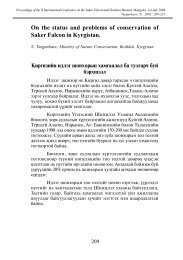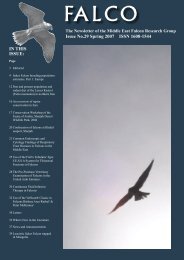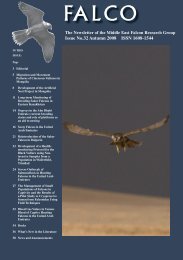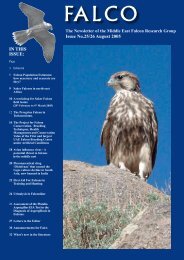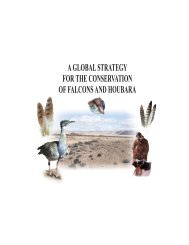Falco cherrug - International Wildlife Consultants Ltd.
Falco cherrug - International Wildlife Consultants Ltd.
Falco cherrug - International Wildlife Consultants Ltd.
You also want an ePaper? Increase the reach of your titles
YUMPU automatically turns print PDFs into web optimized ePapers that Google loves.
Rapid Peregrine decline caused by hydroelctric dam.<br />
Igor Karyakin and A. Pazhenkov<br />
Center of Field Studies, Nizhniy Novgorod, Russia<br />
Ikar_Research@mail.ru<br />
The Peregrine <strong>Falco</strong>n (<strong>Falco</strong> peregrinus) is listed<br />
in the Red Data Book of the Russian Federation (Danilov-<br />
Danielyan 2001) and of the Bashkortostan Republic<br />
(Kucherov 1987). The Southern Urals was a refuge territory<br />
where the species survived during the DDT era and perhaps<br />
has acted as a source population in the re-colonizing of<br />
the former part of the range in Eastern Europe and western<br />
Siberia. The examples of recent negative trends are rarely<br />
reported in scientific literature.<br />
The numbers of Peregrines in Europe was estimated<br />
as 7600-11000 pairs, out of which some 1000 pairs were<br />
breeding in the European part of Russia. Out of these 1,000<br />
pairs about 260 pairs breed in Bashkortostan Republic<br />
(Karyakin, 1998b; Heath et al., 2000). In 2002 the total<br />
numbers of Peregrines in Bashkortostan is estimated as<br />
470-480 pairs, which is about 5% of the European<br />
Population and 34% of the European portion of the Russian<br />
population (Karyakin 2003). The major stronghold of the<br />
Baskir population of Peregrines is located in the Belaya<br />
river valley, where we located 59 breeding territories<br />
(Figure 1) which are regularly occupied (Karyakin 1998a,<br />
1998b).<br />
The Belaya river valley is protected by several<br />
high ranking protected territories: The State Nature Reserve<br />
“Shul’gan Tash”; National Park “Bashkiria” and complex<br />
landscape Nature Reserve (zakaznik) “Altyn-Solok”.<br />
Within the territory under the question there is one Key<br />
Ornithological territory of international importance named<br />
“Bel’sko-Nugushkoe Confluence” (BC-008) (Heath et al.,<br />
2000). The territory has been nominated as a World<br />
Heritage Site (UNESCO). Nevertheless the high rank of<br />
protection status of the territory did not help. In 1999,<br />
breaking 20 laws and legislative documents of both Russia<br />
and the Bashkorstan Republic, it was decided to go ahead<br />
with the construction of the Yumaguskioe water reservoir in<br />
the Belaya river valley. The construction work is ongoing at<br />
the time of writing.<br />
During the construction work in 1999 a part of the<br />
river valley at the place where the river emerges from the<br />
mountain into the Russian Plain has been developed. As a<br />
result two nest sites with inter-nest distance of 870 m have<br />
disappeared. In 2000 the work has continued and by 2003<br />
the valley of the river 50 km upstream had been cleared of<br />
Figure 1. Left: Map of Peregrine nests distribution before flooding the reservoir. Right: Map of Peregrine nest distribution<br />
during the flooding of the reservoir in 2003. Legend: 1 - Forested areas; 2 - Rivers; 3 - Nest sites. Editorial note:We are not<br />
afraid to publish these locations as the population no longer exists after flooding of the valley.<br />
Figure 2a. Left: A peregrine site at the Belaya river before hydroelectric dam works started. Right: The same place (in the<br />
frame) during excavations in 2003 .<br />
13



